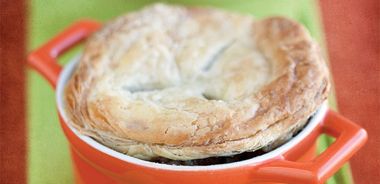Mushroom and Barley Pot Pie

I love mushroom and barley soup so much that I decided a pot pie would be a great way to eat this tasty combination. Use your favourite mushrooms or take this opportunity to try new varieties.
1/2 cup (125 mL) pearl barley
4 Tbsp (60 mL) extra-virgin olive oil, divided, plus extra for oiling pan
1/2 cup (125 mL) finely chopped onion
2 garlic cloves, minced
1 tsp (5 mL) fresh thyme
1 lb (450 g) mixed mushrooms (such as portobello, white button, crimini, shiitake, oyster, trumpet, or chanterelle), trimmed and cut to same size
1 medium carrot, sliced
1 medium celery stalk, sliced
1 Tbsp (15 mL) low-sodium soy sauce
2 fresh sage leaves, finely chopped
1/4 cup (60 mL) flour of your choice, such as whole wheat or a gluten-free option
2 cups (500 mL) low-sodium vegetable stock
1/2 tsp (2 mL) lemon juice
1/4 tsp (1 mL) ground black pepper
1/4 tsp (1 mL) grated nutmeg
1/4 sheet frozen puff pastry
Preheat oven to 400 F (200 C). Lightly brush 8 x 8 in (20 x 20 cm) baking pan or other shallow baking dish with about 1 tsp (5 mL) extra-virgin olive oil and set aside.
Wash, rinse, and then soak barley in cold water. Let stand for 30 minutes, then drain. Boil water and barley in medium saucepan; let simmer uncovered for 12 minutes or until tender. Drain and set aside.
Heat 2 Tbsp (30 mL) oil in sauté pan over medium-high heat. Add onion, garlic, and thyme, and cook for 3 minutes, until onion begins to soften. Add mushrooms, carrot, and celery, and sauté for another 3 minutes. Add soy sauce, sage, and cooked barley. Set aside.
Heat remaining 2 Tbsp (30 mL) oil in large saucepan over medium-low heat. Add flour and whisk until smooth. Cook, whisking constantly, for 2 minutes. Add stock and whisk until smooth. Increase heat to medium and bring mixture to a simmer, whisking constantly. Remove from heat and whisk vigorously to break up any lumps. Add lemon juice, pepper, and nutmeg and stir well. Add vegetables to sauce and pour contents into prepared pan.
Roll out puff pastry to 1/8 in (3 mm) thickness and cut to fit inside pan. Place on top of filling and make a few slashes with knife on top to allow steam to escape. Bake for 25 to 30 minutes, or until filling is bubbling and pastry is golden.
Serves 4.
Each serving contains: 432 calories; 9 g protein; 24 g total fat (5 g sat. fat, 0 g trans fat); 47 g carbohydrates (5 g sugars, 8 g fibre); 294 mg sodium
source: "Pot Pies", alive #361, November 2012




